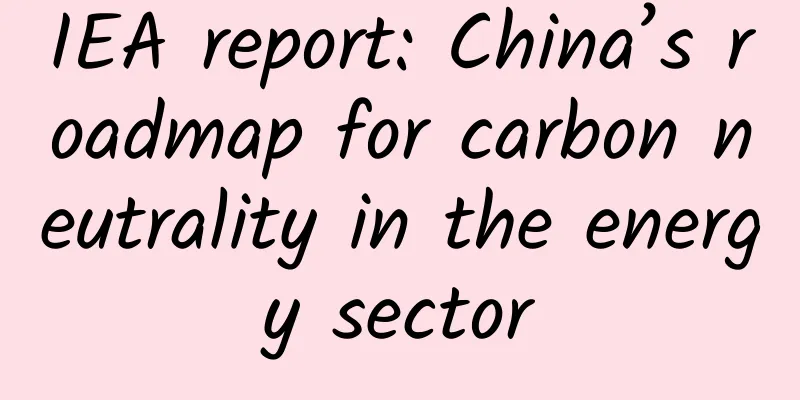IEA report: China’s roadmap for carbon neutrality in the energy sector

|
Over the past four decades, China’s remarkable economic growth has lifted hundreds of millions of people out of poverty and made China a leader in many industries. But at the same time, China has also become the world’s largest carbon emitter, accounting for one-third of global carbon dioxide (CO2) emissions. China supplies more than half of the world’s steel and cement, but CO2 emissions from these two industries alone are greater than the total carbon emissions of the European Union. China aims to peak its CO2 emissions by 2030 and achieve carbon neutrality by 2060. With the energy system accounting for nearly 90% of China’s greenhouse gas emissions, energy policy is at the heart of China’s transition to carbon neutrality. A new report released today by the International Energy Agency – China’s Roadmap to Carbon Neutrality in its Energy System – explores how China can achieve its low-carbon goals while ensuring energy security and affordability for its people. The report shows that the investments required to achieve carbon neutrality are well within China’s reach, given the size and dynamism of its economy. This report is a response to the Chinese government’s invitation to the IEA to collaborate on long-term policy strategy. Dr Fatih Birol, Executive Director of the International Energy Agency, said: “China is a major force in the development of clean energy, playing a leading role in many existing success stories, from solar power to electric vehicles. China’s efforts to achieve its carbon neutrality goal will promote the flourishing of a wider range of low-carbon technologies and drive deep cuts in the use of fossil fuels in the coming decades. “But the really exciting news is that our roadmap shows that China has the means and capacity to achieve a more rapid clean energy transition, which will bring greater social and economic benefits to the Chinese people, while also improving the world’s chances of limiting global temperature rise to 1.5°C,” added Dr Birol. “Such an accelerated transition would result in a significant decline in China’s CO2 emissions after 2025, making it possible for China to achieve carbon neutrality well before 2060. This is good for China and good for the world.” China has made significant progress in its clean energy transition, but it still faces some serious challenges. Coal currently accounts for more than 60% of electricity generation, and China continues to build coal-fired power plants at home. At the same time, China is adding more solar power capacity year after year than any other country. China is the world's second-largest oil consumer, but it is also home to 70% of the world's electric vehicle battery production capacity. At the same time, achieving China’s climate goals cannot rely solely on promoting renewable energy and electric vehicles. It also requires addressing the huge emissions from existing fossil fuel power plants, steel mills, cement kilns and other industrial facilities. If China’s existing emission-intensive energy infrastructure continues to operate in the same way, its carbon dioxide emissions between now and 2060 will account for a third of the global carbon budget needed to limit global warming to 1.5°C. This does not include the new factories that may be built to meet growing demand. The “China Roadmap” outlines a path consistent with the ambitious goals announced by China last year to reach peak carbon emissions by 2030 and achieve carbon neutrality by 2060. In this pathway, the main drivers of emissions reductions through 2030 come from improving energy efficiency, developing renewable energy, and reducing coal use. From 2020 to 2060, renewable energy generation, mainly wind and solar photovoltaic power generation, will increase sevenfold to account for nearly 80% of the national power structure. After 2030, with strong development of emerging innovative technologies such as hydrogen and carbon capture, industrial CO2 emissions will fall by nearly 95% by 2060. These advances will boost China’s labor market. More new jobs will be created in the growing field of low-carbon energy technologies, more than the jobs lost in the declining fossil fuel industry. The roadmap also explores the opportunities and benefits of a faster clean energy transition in China. If China accelerates its transition, CO2 emissions could be 20% lower by 2030 than current levels. In addition to the significant benefit of mitigating the impacts of climate change, the social and economic benefits include boosting prosperity in regions that have not yet benefited fully from China’s economic development and creating more jobs across the country. The cumulative investment required for an accelerated transition is similar to that required for a slower transition, so the need for investment is not an obstacle to a faster transition. The PDF version will be shared on 199IT Knowledge Planet, just scan the QR code below! |
<<: Deloitte: Global Healthcare Outlook Report 2022
>>: Tianlai Karaoke Co-founder Hao Jie: Big screen life connects happiness
Recommend
Case analysis | Analysis of the Xueersi Online School’s Douyin landing page!
Today's case comes from the outstanding conte...
"League of Holy Sword" Review: A hodgepodge of games with all kinds of flavors
With the emergence of the new fertile soil of tel...
13 ways to market on Children's Day
How to do topic marketing on Children's Day? ...
Are there any healthy snacks that won’t make you fat? The truth →
More and more people eat snacks not only to resis...
Tik Tok live streaming skills for the jewelry industry
"Jewelry is silent, but it can move women mo...
Top 10 channels for APP operation and promotion!
As an Internet operator and promoter, do you know...
You will regret it if you don't read this! Eating less meat leads to mental illness? Meat consumption is closely linked to depression, anxiety, and dementia
Meat, as an important component of the human diet...
Sad culture is popular, so is heartfelt marketing far behind?
Looking at the popular advertising cases today, i...
7 ways to express your love to developers on Valentine's Day
[51CTO.com original article] Spring is coming. Wh...
Why didn't the cockroach die after taking the medicine? How to get rid of cockroaches? (Recommended collection)
You may have accidentally seen or clicked on a vi...
Can a non-rotating microwave oven still heat food evenly?
The microwave oven, a convenient tool in the fami...
Brands are mastering private domain operation strategies!
The contents of this article are as follows: Omni...
Competitive analysis and product analysis, have you figured it out?
When I first started working as a product manager...
Why do people in Tianjin like to say this number the most?
In Tianjin You must have heard the number "7...
How to move a 200-ton hotel? Just 700 bars of soap
What tools are needed to move a building? Recentl...









